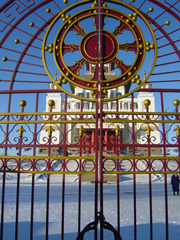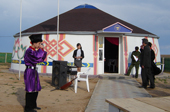Kalmykian Buddhists revive ancient nature hunt
 |
 |
 |
Elista Buddhist Monastery |
In 2006 ARC worked with the Kalmyks, the inhabitants of Kalmykia, Europe’s only Buddhist republic, to help them explore the relationship between Buddhism and Ecology in their schools, their colleges, and their monasteries.
The first two stages of the project, completed in 2006, involved:
1. Running a competition for young people to help revive an ancient nature hunt: a contest to find the cleanest, most beautiful area of the steppes in order to practise ritual veneration of the ovoo. The ovoo is a mound of stones that marks a sacred site in the landscape. Offerings are made by throwing three small rocks onto the ovoo and by walking around it three times in a clockwise direction. Worshipping at these ovoos is a way of thanking nature and the gods and requesting safety on the journey ahead.
2. Publishing a booklet on Buddhism and ecology, intended for students of Buddhist studies and practising monks.
The Hazrin Ezn Competition
ARC also sponsored a Republic-wide competition for young people, intended to reawaken the tradition of “Hazrin Ezn” or “Master of the Steppe”. The Kalmyks traditionally practice an ovoo ritual as part of their veneration of the natural world. The ovoo is traditionally preceded by a competition, judged by the elders, on the most ritually clean site for the ceremony to be held. Nowadays, on the steppes, the number of ritually clean places has been reduced due to a lack of education and the loss of traditional practices in the Soviet years when religion was restricted.
 |
 |
 |
Kalmykia Buddhist Visitor Centre |
This competition encouraged young people from primary and secondary schools to create artworks on the theme of Hazrin Ezn. It was organized and judged by the Centre of Ecological Projects of the Republic of Kalmykia together with teachers and monks from the central Kalmykian Buddhist monastery Geden Shaddup Chup Choi Korving. The purpose was to attract the attention of the general public to problems of nature conservation on the Kalmykian steppes, and the increasingly endangered species of plants and animals. It was advertised widely in the Kalmykian press.
Booklet on Buddhism and Ecology
More than 2,500 years ago the Buddha realised that all the suffering of this life arises from an undisciplined mind, and that to be rid of suffering a person needs to cultivate clarity of mind. This booklet explains how Buddhism in Kalmykia has developed to incorporate many tantric practices. Because of the associations of these practices with nature, the environment has special significance.
“Fresh water springs may appear because of these links or certain animal are found and protected there. Recent research has revealed that Buddhist Huruls (monasteries) and Stupas, as a rule, were put in places of geomagnetic intensity that transforms destructive energy in an environment and creates a harmonious balance.”
In 1994, under the initiative of the Dharma Centre of Kalmykia, a spiritual/ecological expedition took place called the ‘Precious Necklace of Kalmykia’. The aim was to visit sites with significant spiritual associations, including sites of earlier Buddhist monasteries, stupas, sacred springs etc. The expedition raised awareness of their spiritual and natural significance through lectures at schools and colleges, and also through teachings at monasteries.
Plans
The Kalmyks' plans in 2006 included:
• setting up a Buddhist “econet” in Kalmykia,
• developing a Buddhist eco-park in the capital of Elista
• creating a protected natural area in Iki-Burulskogo, focused around a working Dharma Centre
• Equipping a visitor centre near the Saiga Antelope Breeding Centre with environmental and Buddhist and ecology resources.
• organising further expeditions to places with significant spiritual associations, with the aim of raising awareness of their natural as well as spiritual significance.
Kalmykia is a small autonomous republic in south-western Russia, bordering on the Caspian Sea. It has a population of some 350,000 and the capital, Elista, houses some 85,000 people. Nearly half the people are Kalmyk. An Institute for the Rebirth of the Kalmyk Language and Buddhism was established in the early 1990s, and today Buddhist holidays are celebrated nationally.
Links
BBC Country Profile on Kalmykia.
Information from the Kalmykia Embassy.
Wikipedia.
|

